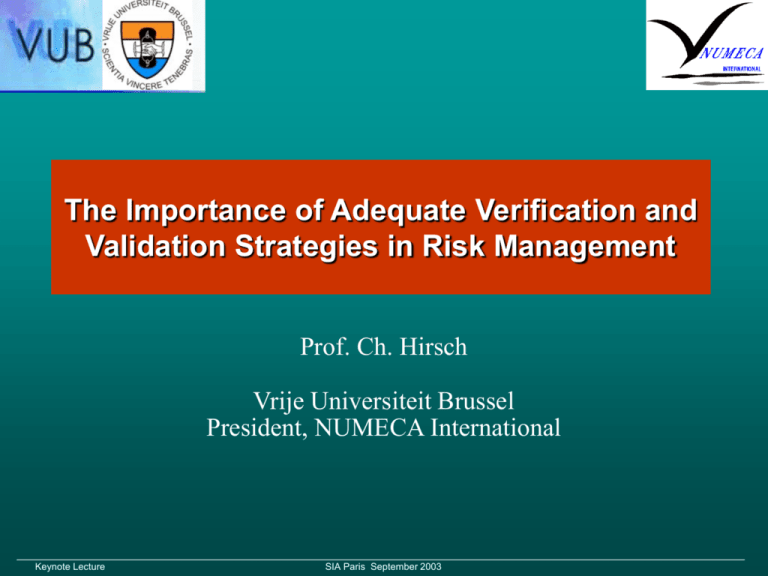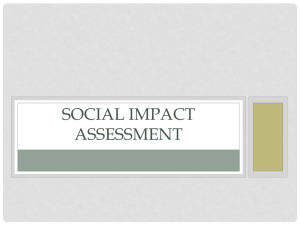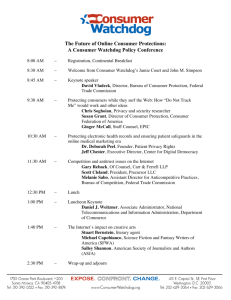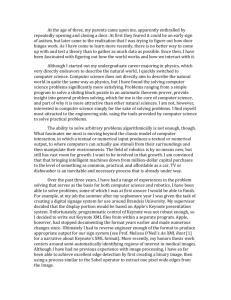New Trends and Requirements on Unstructured Grid Generation
advertisement

The Importance of Adequate Verification and Validation Strategies in Risk Management Prof. Ch. Hirsch Vrije Universiteit Brussel President, NUMECA International ____________________________________________________________________________________________________________________________ Keynote Lecture SIA Paris September 2003 Content Introduction Error identification and management Verification requirements Validation requirements Beyond V&V The new generation of simulation tools Non-deterministic simulations Robust design methodologies Conclusions _________________________________________________________________________________________________________________________ Keynote Lecture SIA Paris September 2003 Slide 1 Introduction What’s new in simulation and Computer Assisted Engineering (CAE) CAE covers all areas of physical simulation, particularly Computational Structural Mechanics (CSM) Computational Fluid dynamics (CFD) Computational Electromagnetics (CEM) Growth of computer power leads to unprecedented levels of CAE simulations Million of points or degree of freedoms (DoF) Complex geometries Multiphysics (coupling fluid-thermal; fluid-structure; aeroacoustics,…) Leading to Multidisciplinary design and optimization software systems (MDO) _________________________________________________________________________________________________________________________ Keynote Lecture SIA Paris September 2003 Slide 2 Objectives This leads to a growing request for quality assurance (QA) on the simulation tools In order to respond to this request, joint efforts are required to define: uncertainty bounds on simulation results limits on models error control methodologies appropriate test cases and QA strategies _________________________________________________________________________________________________________________________ Keynote Lecture SIA Paris September 2003 Slide 3 Validation and verification Validation: The process of determining the degree to which a model is an accurate representation of the real world from the perspective of the intended uses of the model. Verification: The process of determining that a model implementation accurately represents the developer's conceptual description of the model and the solution to the model. Verification is a prerequisite, upstream of the validation process and requires a dedicated effort towards adequate methodology _________________________________________________________________________________________________________________________ Keynote Lecture SIA Paris September 2003 Slide 4 V&V _________________________________________________________________________________________________________________________ Keynote Lecture SIA Paris September 2003 Slide 5 Identification of Error Sources Model errors and uncertainties Difference between exact solution of the equations and real flow Turbulence model uncertainties predominate Application uncertainties Uncertain boundary conditions or geometry Discretization or numerical errors Difference between exact solution and solution on a finite grid In industrial CFD, solutions are usually not grid independent Iteration or convergence error Difference between converged solution and result after n steps User errors Mistakes, blunders, carelessness, optimism, etc., Programming or code errors (bugs) _________________________________________________________________________________________________________________________ Keynote Lecture SIA Paris September 2003 Slide 6 Verification process _________________________________________________________________________________________________________________________ Keynote Lecture SIA Paris September 2003 Slide 7 Verification process No matter how many tests and empirical experiments we perform, we can never prove that a software implementation is error free, or has zero software defects. Experience suggests that one can never totally eliminate bugs from complex CFD software, certainly not simply by performing algorithm testing alone. An important approach to algorithmic testing in verification is the method of manufactured solutions From W.L. Oberkampf, T. G. Trucano, Ch. Hirsch (2002), Verification, Validation, and Predictive Capability in Computational Engineering and Physics. Paper presented at FOUNDATIONS 02, Foundations for Verification and Validation in the 21st Century Workshop, October 2002 _________________________________________________________________________________________________________________________ Keynote Lecture SIA Paris September 2003 Slide 8 Validation process _________________________________________________________________________________________________________________________ Keynote Lecture SIA Paris September 2003 Slide 9 Validation hierarchy _________________________________________________________________________________________________________________________ Keynote Lecture SIA Paris September 2003 Slide 10 Validation – Application domain In case a) we have high confidence that the relevant physics is understood and modeled at a level that is commensurate with the needs of the application. In case b) the boundary of the domain indicates that outside this region there is a degradation in confidence in the quantitative predictive capability of the model. Outside the validation domain the model is credible, but its quantitative capability has not be demonstrated. From W.L. Oberkampf, T. G. Trucano, Ch. Hirsch (2002), Verification, Validation, and Predictive Capability in Computational Engineering and Physics. Paper presented at FOUNDATIONS 02, Foundations for Verification and Validation in the 21st Century Workshop, October 2002 _________________________________________________________________________________________________________________________ Keynote Lecture SIA Paris September 2003 Slide 11 Validation – Application domain Figure 5a depicts the prevalent situation in engineering which shows the complete overlap of the validation domain with the application domain. The vast majority of modern engineering system design is represented in Fig. 5a. Figure 5b represents the occasional engineering situation where there is significant overlap between the validation domain and the application domain. Some examples are: prediction of crash response of new automobile structures, entry of spacecraft probes into the atmosphere of another planet, and the structural response of new designs for deep-water offshore oil platforms. Figure 5c depicts the situation where there is no overlap between the validation domain and the application domain. Predictions for many high-consequence systems are in this realm because we are not able to perform experiments for closely related conditions. The inference from the validation domain can only be made using both physics-based models and statistical methods. Model calibration, which employs explicit tuning or updating of model parameters to achieve some degree of agreement with existing validation experiments, does not fully assess uncertainty in the predictive use of the model. The requirement for predictive code use far from the validation database necessitates extrapolation beyond the understanding gained strictly from experimental validation data. For example, the modeling of specific types of interactions of physical processes may not have been validated together in the given validation database. There is then uncertainty in the accuracy of model predictions _________________________________________________________________________________________________________________________ describing such interactions. Keynote Lecture SIA Paris September 2003 Slide 12 Dramatic illustration A significant example is to be found in the recent report from NASA about the failure of the scramjet hypersonic vehicle experiment X-43A. The report, issued recently at http://www.space.com, mentions:“SPACE.com has learned that the failure of the NASA X43A hypersonic aircraft in June 2001 was the result of inaccuracies in computer and wind-tunnel tests that were based on insufficient design information about the vehicle itself”. According to the NASA-MIB documents, the X-43A Hyper X launch vehicle "failed because the vehicle control system design was deficient for the trajectory flown due to inaccurate analytical models, which overestimated the system margins." _________________________________________________________________________________________________________________________ Keynote Lecture SIA Paris September 2003 Slide 13 VERIFICATION AND VALIDATION EFFORTS IN EUROPE ____________________________________________________________________________________________________________________________ Keynote Lecture SIA Paris September 2003 European activities Various collective efforts in Europe for CFD validation ERCOFTAC: privately funded action on CFD Quality and Trust QNET-CFD: Thematic Network on Q&T FLOWNET: Collection of data for validation test cases ECORA: Q&T for CFD in the nuclear industry _________________________________________________________________________________________________________________________ Keynote Lecture SIA Paris September 2003 Slide 15 PHASE 1: ERCOFTAC BEST PRACTICE GUIDELINES _________________________________________________________________________________________________________________________ Keynote Lecture SIA Paris September 2003 Slide 16 Objectives Guide to avoid the most common pitfalls: Guidelines not specific to individual codes, methods or applications Guidelines that have very wide support Not exhaustive: 20% of rules to cover 80% of aspects Modular form for each topic: Discussion section Problem description and discussion, including references to important books, articles and reviews with relevant examples for the user. Short simple statements of advice which provide clear guidance, are generally accepted, and are easily understandable without elaborate mathematics. _________________________________________________________________________________________________________________________ Keynote Lecture SIA Paris September 2003 Slide 17 Follow-up Application Data-base Extension Library of industrially relevant challenging problems with quality test data and CFD available Extension of scope of BPG to more difficult flow regimes Revision Expert Knowledge-base Expert knowledge on limits of physical models in specific flow regimes ERCOFTAC Best Practice Guidelines Updates, corrections and improvements within current scope Application Procedures Advice on how to best do CFD and statements on accuracy for relevant industrial cases _________________________________________________________________________________________________________________________ Keynote Lecture SIA Paris September 2003 Slide 18 PHASE II THE QNET-CFD NETWORK _________________________________________________________________________________________________________________________ Keynote Lecture SIA Paris September 2003 Slide 19 Objectives To assemble, structure and collate existing knowledge on the industrial application of CFD and to make these available to European industry To improve the quality of the industrial application of CFD To improve the level of trust that can be placed in industrial CFD calculations by assembling, structuring and collating existing know-ledge encapsulating the performance of models underlying the current generation of CFD codes To establish a shared database of computational and experimental results to support industrial applications To provide a regular state-of-the-art review on quality and trust To promote technology transfer between industries through workshops, regular meetings and electronic communication _________________________________________________________________________________________________________________________ Keynote Lecture SIA Paris September 2003 Slide 20 Membership 44 participating organisations with representatives from : 8 European Union member states 1 EFTA member state 2 Pre-accession states The membership is principally built from industries, although there is a strong representation from universities and research organisations A diverse range of industrial sectors is represented, including industries as diverse as civil construction and textiles Also included: representatives from the major European CFD code vendors The organisations involved range from large industrial concerns to SME’s _________________________________________________________________________________________________________________________ Keynote Lecture SIA Paris September 2003 Slide 21 Research Centres DERA Health and Safety Executive NCSRD The Meteorological Office CEA CIRA CIMNE Vattenfall Utveckling AB Czech Academy of Science Universities University of Brussels (VUB) University of Karlsruhe University of Surrey University of Poitiers University of Southampton University of Rome Martin-Luther-Universitat NTUA FH Niederrhein Cranfield University University of Florence University of Czestochowa Q N E T C F D Industries WS Atkins Science & Technology CFS Engineering SA Renault Sulzer Innotec NUMECA Int. Electricite de France SNECMA Moteurs MTU AEA Technology BMW Rolls-Royce MAN Turbo ABB ALSTOM Technology Rolls-Royce Power Engineering Fluent Europe Magnox Electric Mott MacDonald SNPE Propulsion HR Wallingford Arup R&D Computational Dynamics British Nuclear Fuels ABB Power UK _________________________________________________________________________________________________________________________ Keynote Lecture SIA Paris September 2003 Slide 22 Work Procedure Development of knowledge base Develop Quality & Trust knowledge base that consist of a library of application challenges (AC) within each of the industry sectors and information on a series of well-documented flow regimes that underlie these industrial applications Identification and documentation of application challenges Quality checks of application challenges Identification of underlying flow regimes (UFR) Documenting underlying flow regimes and development of best practice advice Quality checks on underlying flow regimes and review of best practice advice Development of application challenge best practice advice Review of best practice advice Exploitation of knowledge base after end of project _________________________________________________________________________________________________________________________ Keynote Lecture SIA Paris September 2003 Slide 23 Quality Control Quality Control is a major element through the QNET-CFD operation Managed by a “Quality Coordinator” (A. Hutton) and a “Scientific Coordinator” (W. Rodi) A Quality procedure document has been generated, providing guidelines for acceptance or rejection of submitted AC’s All AC’s have been screened and cross-reviewed by 2 partners After acceptance, they are recorded in the knowledge and data base. _________________________________________________________________________________________________________________________ Keynote Lecture SIA Paris September 2003 Slide 24 Thematic Areas The Network is organised around 6 Thematic Areas (TA) aligned with the following industrial sectors : TA 1 : EXTERNAL AERODYNAMICS TA 2 : COMBUSTION AND HEAT TRANSFER TA 3 : CHEMICAL PROCESS, THERMAL HYDRAULICS AND NUCLEAR SAFETY TA 4 : CIVIL CONSTRUCTION & HVAC TA 5 : ENVIRONMENT TA 6 : TURBOMACHINERY INTERNAL FLOWS Each Thematic Area has a TA coordinator that assumes responsibility for the activities of the group _________________________________________________________________________________________________________________________ Keynote Lecture SIA Paris September 2003 Slide 25 Underlying flow regimes – UFR Subdivided in 4 categories UFR 1 -- Free flows UFR 2 -- Flow around bodies UFR 3 -- Semi-confined flows UFR 4 -- Confined flow Each UFR can be attributed to several AC’s Contains experimental data and a variety of CFD simulations, from which Best Practice Advice (BPA) guidelines are derived From the collection of BPA’s of all the UFR’s associated to an AC, a BPA for the AC is to be established _________________________________________________________________________________________________________________________ Keynote Lecture SIA Paris September 2003 Slide 26 UFR 1 -- Free flows 1-01 Underexpanded jet Partner-07 1-02 Blade tip and tip clearance vortex flow Partner-09 1-03 Buoyant plumes 1-04 Annular coaxial jets, flow and mixing Partner-12 Partner-19 1-05 Jet in a cross flow Partner-36 _________________________________________________________________________________________________________________________ Keynote Lecture SIA Paris September 2003 Slide 27 UFR 2 -- Flow around bodies 2-01 Blunt base flow (streamwise flow past cylinder with cut-off end) 2-02 Flow past cylinder 2-03 Flow around oscillating airfoil 2-04 Flow around (airfoils and) blades (subsonic) 2-05 Flow around airfoils (and blades) A-airfoil (Ma=0.15, Re/m=2x106) 2-06 Flow around (airfoils and) blades (transonic) 2-07 3D flow around blades 2-08 Flow around grid bars 2-09 Rotor/stator interaction _________________________________________________________________________________________________________________________ Keynote Lecture SIA Paris September 2003 Slide 28 UFR 3 -- Semi-confined flows 3-01 3-02 3-03 3-04 3-05 3-07 3-08 3-09 3-10 3-11 3-12 3-13 3-14 3-15 3-16 Boundary layer interacting with wakes under adverse pressure gradient - NLR 7301 high lift configuration Atmospheric boundary layer with rough wall 2D Boundary layers with pressure gradients Laminar-turbulent boundary layer transition Shock/boundary-layer interaction (on airplanes) Natural and mixed convection boundary layers on vertical heated walls 3D boundary layers under various pressure gradients, including adverse pressure gradient causing separation Impinging jet Plane wall jet Plane wall jet in counter current flow Stagnation point flow Flow over isolated hills/valleys (without dispersion) Flow over surface-mounted cube/rectangular obstacles 2D flow over backward facing step Wave-driven flow in a basin _________________________________________________________________________________________________________________________ Keynote Lecture SIA Paris September 2003 Slide 29 UFR 4 -- Confined flow 4-01 Secondary flow in rotating and non-rotating channels 4-02 Confined coaxial swirling jets 4-03 Pipe flow - rotating 4-04 Pipe flow - non rotating 4-05 Curved duct/pipe flow (accelerating) 4-06 Swirling diffuser flow 4-07 Developing channel flow with mass injection through wall 4-08 Orifice/deflector flow 4-09 Confined buoyant plume 4-10 Natural convection in simple closed cavity 4-11 Simple room flow 4-12 Flows in chambers with multiple inlet/outlets 4-13 Compression of vortex in cavity _________________________________________________________________________________________________________________________ Keynote Lecture SIA Paris September 2003 Slide 30 Best Practice Advices To be derived from the BPA of individual UFR BPA to be strongly supported by the evidence examined in the UFR document Section on “Comparison of CFD Calculations with Experiments” Recommendations for Future Work Such as new experiments to be undertaken for which the values of key parameters are much closer to those encountered in real application challenges Visit http://www.qnet-cfd.net _________________________________________________________________________________________________________________________ Keynote Lecture SIA Paris September 2003 Slide 31 THE FUTURE OF V&V _________________________________________________________________________________________________________________________ Keynote Lecture SIA Paris September 2003 Slide 32 New approach to V&V It is generally recognized that, although actions towards the reduction of simulation uncertainties are still required, numerous sources of uncertainties will always remain. Therefore new methodologies are required in order to incorporate the presence of uncertainties in the simulation process and in order to introduce the existence of these “uncertain” simulation results in the decision process related to industrial design. This implies responses to the following questions How to manage uncertainties in simulations, that is how to quantify, in a rational way, the impact of the different sources of uncertainties on the simulation results. Given the existence of “uncertain” simulation results, how are multidisciplinary design optimizations (MDO) techniques to be developed and applied in order to support the industrial design process? _________________________________________________________________________________________________________________________ Keynote Lecture SIA Paris September 2003 Slide 33 Next steps _________________________________________________________________________________________________________________________ Keynote Lecture SIA Paris September 2003 Slide 34 Required steps – 1 Quantification uncertainties and management of simulation Quantification and management of uncertainties is required at the individual discipline level (CFD, CSM, CHT,…) as well as at the integrated system level. The current practice of CAE simulations is based on deterministic parameters such as fixed boundary or initial conditions, fixed geometry and physical properties, fixed physical model parameters, etc. However, these conditions are not generally known precisely and are attached with unavoidable error levels, as listed above. Therefore one should be able to evaluate simulation results by incorporating these uncertainties in the simulation process, in order to approach a rational quantification of uncertainties, including the establishment of a confidence interval for the simulation-based predictions. _________________________________________________________________________________________________________________________ Keynote Lecture SIA Paris September 2003 Slide 35 Required steps – 1a Quantification of uncertainties Methods have to be developed to achieve the following objectives model and quantify the “parameter” uncertainties and stochastic inputs (such as initial conditions, boundary conditions, geometrical uncertainties) model the “modeling” uncertainties associated with physical models, transport properties, source terms specification of the nature of the parameter and model uncertainties (interval limits, probability density distributions, fuzzy logic sets,…) quantification of the parameter (and model uncertainties, based on all possible sources of information, including experimental data, analytical estimates, results from computational processes, …. _________________________________________________________________________________________________________________________ Keynote Lecture SIA Paris September 2003 Slide 36 Quantification of uncertain variables _________________________________________________________________________________________________________________________ Keynote Lecture SIA Paris September 2003 Slide 37 Required steps – 1b Management of uncertainties Implement probabilistic simulations, for which innovative mathematical and algorithmic methods have to be developed for the treatment of differential equations containing stochastic input parameters and model parameters. Several methods are to be developed, assessed and validated, such as perturbation techniques whereby the variables of the problem are expanded in terms of Taylor series around their mean value (mainly for Gaussian or weakly non-Gaussian processes) Monte Carlo methods for complete statistics, but generally excessively expensive Fuzzy logic methods. Fuzzy logic allows to create models based on inexact, incomplete, or unreliable knowledge or data, and, moreover, to infer approximate behavior of the system from such models Polynomial Chaos methods, whereby the randomness of the solution uncertainties is represented and the PDF of the different solution components is defined at every point and time. _________________________________________________________________________________________________________________________ Keynote Lecture SIA Paris September 2003 Slide 38 Management of uncertainties Examples of probabilistic output for a model equation, with a relative viscosity variation _________________________________________________________________________________________________________________________ Keynote Lecture SIA Paris September 2003 Slide 39 Probabilistic Design and Risk management Traditional New non-deterministic approach Introduction of probabilistic simulations into the design and decision process _________________________________________________________________________________________________________________________ Keynote Lecture SIA Paris September 2003 Slide 40 Probabilistic Design approach The objectives are therefore To develop aerodynamic and structural optimization algorithms that provides designs, which are robust with respect to uncertainties in geometry, operating conditions, and code simulation uncertainties. To control and reduce risks by providing designs with performances insensitive to intrinsically uncertain quantities To reduce system risks by enabling uncertainty quantification and design strategies at the conceptual design stage _________________________________________________________________________________________________________________________ Keynote Lecture SIA Paris September 2003 Slide 41 Probabilistic Design approach The two major classes of uncertainty-based design problems are robust design problems and reliability-based design problems. A robust design problem seeks a design that is relatively insensitive to small changes in the uncertain quantities. A reliability-based design seeks a design that has a probability of failure that is less than some acceptable value. _________________________________________________________________________________________________________________________ Keynote Lecture SIA Paris September 2003 Slide 42 Conclusions Classical verification and validation require a large scale effort, which has to continue, although we will never eliminate uncertainties. Risk management needs new generation methods to allow for The quantitative assessment and management of simulation uncertainties by Non-Deterministic methodologies Efficient probabilistic simulation outputs to quantify reliability bounds of the predictions (mean and standard deviations of relevant design quantities) in a rational way, The development and application of design methodologies incorporating probabilistic based simulations _________________________________________________________________________________________________________________________ Keynote Lecture SIA Paris September 2003 Slide 43 Conclusions The non-deterministic approach is critical in order to Reduce system risks by enabling uncertainty quantification. Increase design confidence and safety by measuring and controlling uncertainty in performance predictions and to enable estimates of probabilities of failure _________________________________________________________________________________________________________________________ Keynote Lecture SIA Paris September 2003 Slide 44 Thank you for your attention ! _________________________________________________________________________________________________________________________ Keynote Lecture SIA Paris September 2003 Slide 45








